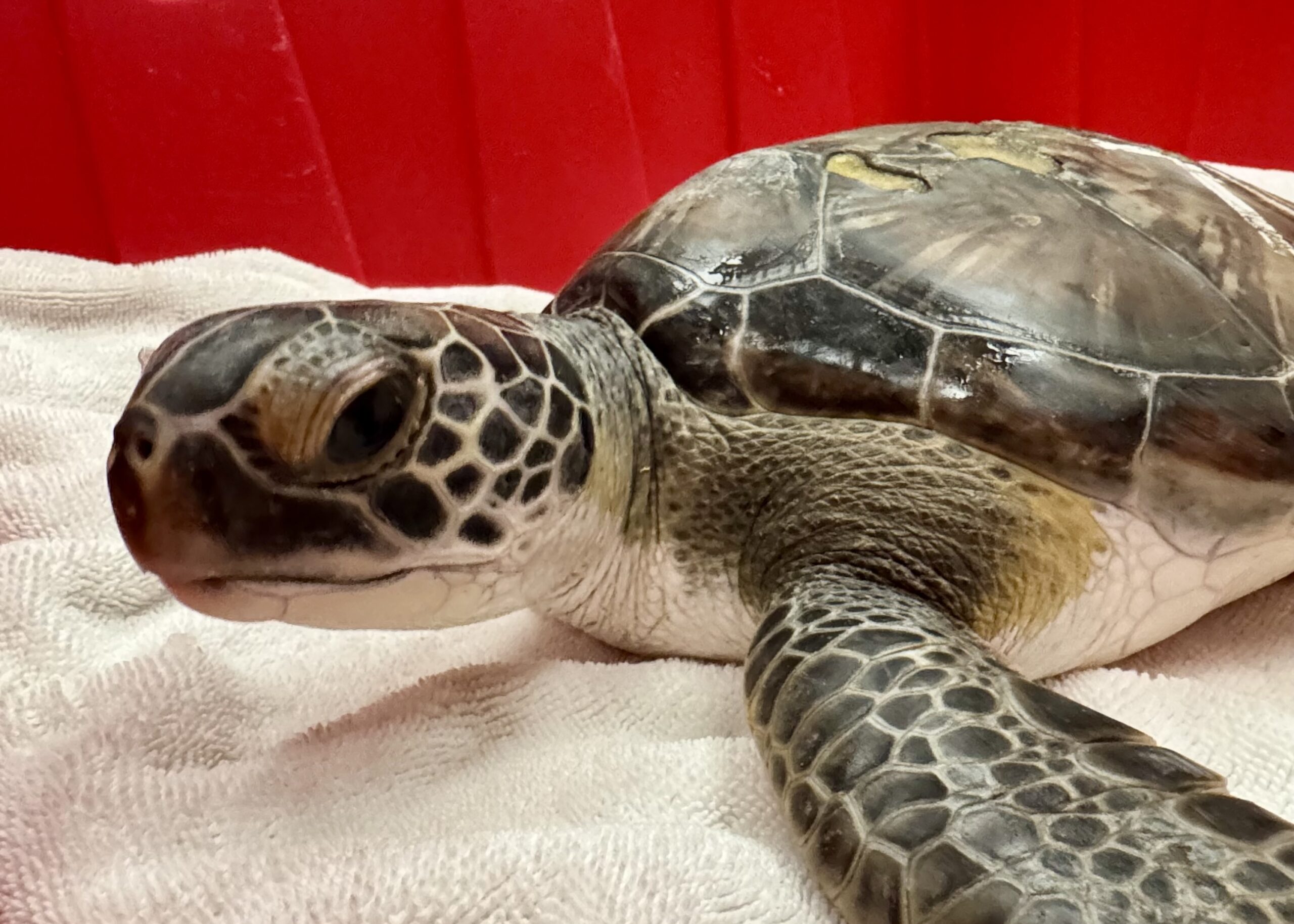Green (Chelonia mydas)
Stranding Location: Seabrook Island, SC
Arrival Date: 3/21/25
Age: Juvenile
Sex: Unknown
Weight: 3.83 kg (8.4 lbs)
Case History
This juvenile green sea turtle was found cold stunned and washed ashore in Seabrook Island. South Carolina Department of Natural Resources permitted volunteers responded and transported the sea turtle to the Aquarium for treatment.
Treatment
Upon arrival, Rose was alert and reactive when handled. This little green was cold to the touch and had an internal body temperature of 51 degrees Fahrenheit as well as a decreased heart rate.
Through a combination of microchip and visible identification markers, we were able to determine that this turtle had been previously encountered during a different cold stun event. After being rehabilitated and released from another facility, Rose unfortunately later found her/his way back into colder waters and was once again affected by the chilly temperatures. Unfortunately, this time, the thermal impacts also damaged the carapace (top shell), and resulted in areas of missing keratin and exposed bone. We took radiographs to look not only at the bone involvement, but also at the condition of the lungs. Sea turtles suffering from cold stunning often present with pneumonia, and Rose’s breaths sounded raspy. We did see some bronchial patterns that may indicate pneumonia, but Rose was too active to sit still for a proper CT scan.
While it is a good sign that Rose is strong and in good body condition, we could not risk sedating her/him for imaging due to the poor blood values that resulted from the hypothermia. We will follow up with a CT scan once Rose is stable enough to be safely sedated. We treated Rose with fluids and vitamins and allowed Rose to rest overnight in a climate-controlled room. By setting the thermostat accordingly, we can make sure that Rose’s body temperature gradually and safely increases to the desired level. Once the body temperature is closer to 70 degrees F, Rose will be metabolizing better and we can start further treatments, like antibiotics.
Updates
March 24, 2025: Rose’s body temperature slowly warmed over the past couple of days and s/he became more active. Once Rose’s temperature was within a couple degrees of the tank water temperature, we were able to swim test this little green in a half-full tank. Thankfully, Rose looks strong and is able to safely stay in the water! We will begin slowly offering food items and administering antibiotics to begin to treat the shell damage. Fingers crossed for this green sea turtle!
April 15, 2025: In the past few weeks, Rose has been slowly acclimated to a more normal body temperature and has even begun to eat and defecate. All of these are important benchmarks, and since Rose was finally a little more stable, we sedated her/him and took a CT to get a better look at the damage to the carapace, as well as check the lungs for pneumonia. The CT showed some potential pneumonia in both lungs and gave us a better view of the lesions to the carapace. These lesions are larger than what is currently visible to the naked eye on the shell, so we expect more keratin to shed in the coming weeks. To help Rose recover, s/he is on injectable antibiotics in addition to oral antifungal medication. Hopefully, the combination of these treatments is effective, and Rose will eventually make a full recovery.
May 15, 2025: Rose continues to be a model patient and takes all of her/his oral medications very well! Rose is quite unique — s/he is very picky about what type of fish is on the menu. Rose has a strong preference for lake smelt, which is a very nutritious and calcium-rich fish, and does not want to eat the mackerel or salmon. Most of our patients have the opposite preference but like always, we cater to our individual patient particularities!
June 15, 2025: Rose has continued to be an interesting case. As we anticipated, some of Rose’s exposed pieces of dead bone began to come loose. Since this began a few weeks ago, we have been doing weekly treatments to remove these pieces. This is one of those cases where the wounds are going to look worse before they get better. As each bone piece is ready to come out, we are carefully evaluating, cleaning and photo documenting the area to track wound progression. With most of these bone pieces being over the vertebrae, we are constantly evaluating Rose’s nerve function which includes making detailed observations about her/his buoyancy, flipper mobility, appetite and defecations. This journey will be a long one and Rose’s treatments are constantly being adjusted. So far, we have not seen any negative changes in Rose’s behaviors and abilities! We are cautiously optimistic about Rose’s prognosis since her aliments involve such delicate areas of her body. Our goal with every patient is to provide treatment to ensure the best quality of life!


